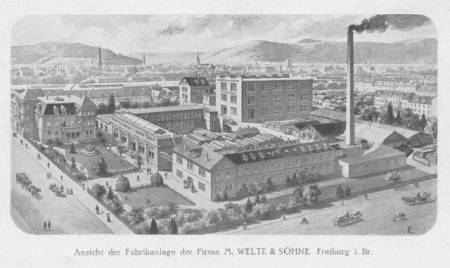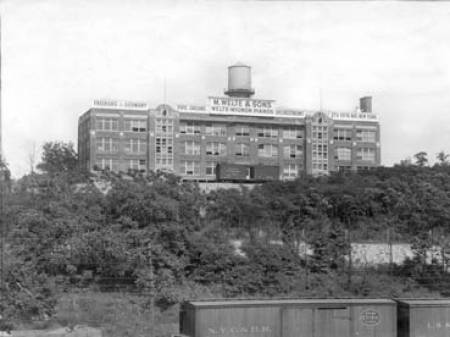The History of M. Welte & Sons, Freiburg and New York
From 1832 until 1932, the firm produced mechanical musical Instruments of high quality. The founder Michael Welte and his company was prominent in the technical and qualitative aspects in their construction of orchestrions produced from 1850 to the beginning of the 20th Century.
In 1872 the firm moved from the remote black forest town Vöhrenbach to Freiburg im Breisgau to a newly developed business complex beneath the main railway-station.
They entered into an epoch-making development when they substituted the playing gear of their instruments from the vulnerable wooden pinned cylinders through perforated paper rolls. In 1883 Emil Welte patented this paper roll method.
With a branch in New York and Moscow and representatives world wide, one can absolutely consider the firm as one of the „global players“ in those days.
Further more the firm was already famous for the inventions in the field of the reproduction of music when Welte introduced the Welte-Mignon reproducing piano in 1904, which came onto the market in 1905.
Through this invention by Edwin Welte and his brother-in-law Karl Bockisch it became possible to reproduce the music once played by a pianist as true to nature as possible.

The Company Buildings of M. Welte & Sons in Freiburg about 1909.
The technical mastership was then a sensation and it enables us today to listen to authentic reproduction of recordings on the few well-preserved Instruments. From 1912 on, a similar system for organs with the name „Welte Philharmonie-Orgel“ was produced.
In 1912 an new company was founded, the „M. Welte & Sons. Inc.“ in New York, which built a new factory in Poughkeepsie, N.Y.

The Factory Building in Poughkeepsie, N.Y. about 1913
The loss of the American branch during WW I met the company hard. The economic crisis and the invention of new technologies like the radio and the electric record player about 1926 was almost the end of the firm with its expensive instruments. World wide the whole line of business in this field came to an end. In 1932, the firm could escape bankruptcy only by building furthermore exclusively church organs and other special organs, now with Karl Bockisch as sole owner.
The last project of Edwin Welte was an electronic organ provided with photo-cells, the Lichttonorgel (Photo tone-Organ)”.
In 1936, a prototype of such an organ was demonstrated in a concert in Berlin. The production of these organs - in cooperation with the Telefunken Company - was halted because the inventor, Edwin Welte, had a Jewish wife.
The business complex in Freiburg was bombed and completely destroyed in November 1944.
This event seemed to obscure the closely kept secret of the firm and the recording apparatus and recording process appeared lost forever. But in recent years parts of the recording apparatus for the Welte Philharmonie organs and documents were found in the United States. It was then possible to reconstruct the recording process at last theoretically. In the Augustinermuseum the inheritance of the firm is preserved - all that survived the Second World War.
![[EN]](../img/gblogo.gif)
![[DE]](../img/delogo.gif)


